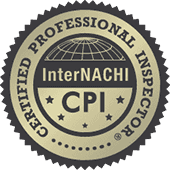|
|
II. The inspector is not required to:
A. insert any tool, probe or device into the main panelboard, sub-panels, distribution panelboards, or electrical fixtures.
B. operate electrical systems that are shut down.
C. remove panelboard cabinet covers or dead front covers, if they are not readily accessible.
D. operate or reset overcurrent protection devices or overload devices.
E. operate non-accessible smoke detectors.
F. measure or determine the amperage or voltage of the main service equipment, if not visibly labeled.
G. inspect the fire or alarm system and components.
H. inspect the ancillary wiring or remote control devices.
I. activate any electrical systems or branch circuits which are not energized.
J. inspect low-voltage systems, electrical de-icing tapes, swimming pool wiring, or any time-controlled devices.
K. verify the service ground.
L. inspect private or emergency electrical supply sources, including, but not limited to: generators, windmills, photovoltaic solar collectors, or battery or electrical storage facility.
M. inspect spark or lightning arrestors.
N. inspect or test de-icing equipment.
O. conduct voltage drop calculations.
P. determine the accuracy of labeling.
Q. inspect exterior accent lighting.
2.8. Fireplace
I. The inspector shall inspect:
A. the fireplace, and open and close the damper door, if readily accessible and operable;
B. hearth extensions and other permanently installed components;
C. and report as in need of repair deficiencies in the lintel, hearth and material surrounding the fireplace, including fireplace opening clearance from visible combustible materials.
II. The inspector is not required to:
A. inspect the flue or vent system.
B. inspect the interior of chimneys or flues, fire doors or screens, seals or gaskets, or mantels.
C. determine the need for a chimney sweep.
D. operate gas fireplace inserts.
E. light pilot flames.
F. determine the appropriateness of any installation.
G. inspect automatic fuel-feed devices.
H. inspect combustion and/or make-up air devices.
I. inspect heat distribution assists, whether gravity controlled or fan-assisted.
J. ignite or extinguish fires.
K. determine adequacy of draft or draft characteristics.
L. move fireplace inserts, stoves, or firebox contents.
M. perform a smoke test.
N. dismantle or remove any component.
O. perform a National Fire Prevention Association (NFPA)-style inspection.
P. perform a Phase I fireplace and chimney inspection.
2.9. Attic, Ventilation & Insulation
I. The inspector shall inspect:
A. the insulation in unfinished spaces;
B. the ventilation of attic spaces;
C. mechanical ventilation systems;
D. and report on the general absence or lack of insulation in
unfinished spaces.
II. The inspector is not required to:
A. enter the attic or any unfinished spaces that are not readily accessible, or where entry could cause damage or pose a safety hazard to the inspector, in his or her opinion.
B. to move, touch, or disturb insulation.
C. to move, touch or disturb vapor retarders.
D. break or otherwise damage the surface finish or weather seal on or around access panels and covers.
E. identify the composition or exact R-value of insulation material.
F. activate thermostatically operated fans.
G. determine the types of materials used in insulation or wrapping of pipes, ducts, jackets, boilers and wiring.
H. determine the adequacy of ventilation.
2.10. Doors, Windows & Interior
I. The inspector shall:
A. open and close a representative number of doors and windows;
B. inspect the walls, ceilings, steps, stairways and railings;
C. and report as in need of repair any spacing between intermediate balusters, spindles or rails for steps, stairways and railings that permit the passage of an object greater than 4 inches in diameter;
D. inspect garage doors and garage door openers by operating first by remote (if available), and then by the installed automatic door control;
E. and report as in need of repair any installed electronic sensors that are not operable or not installed at proper heights above the garage door;
F. and report as in need of repair any door locks or side ropes that have not been removed or disabled when garage door opener is in use;
G. and report as in need of repair any windows that are obviously fogged or display other evidence of broken seals.
II. The inspector is not required to:
A. inspect paint, wallpaper, window treatments or finish treatments.
B. inspect central vacuum systems.
C. inspect safety glazing.
D. inspect security systems or components.
E. evaluate the fastening of countertops, cabinets, sink tops or fixtures.
F. move furniture, stored items, or any coverings, such as carpets or rugs, in order to inspect the concealed floor structure.
G. move drop-ceiling tiles.
H. inspect or move any household appliances.
I. inspect or operate equipment housed in the garage, except as otherwise noted.
J. verify or certify safe operation of any auto-reverse or related safety function of a garage door.
K. operate or evaluate any security bar release and opening mechanisms, whether interior or exterior, including their compliance with local, state or federal standards.
L. operate any system, appliance or component that requires the use of special keys, codes, combinations or devices.
M. operate or evaluate self-cleaning oven cycles, tilt guards/latches or signal lights.
N. inspect microwave ovens or test leakage from microwave ovens.
O. operate or examine any sauna, steam-jenny, kiln, toaster, ice-maker, coffee-maker, can-opener, bread-warmer, blender, instant hot water dispenser, or other small, ancillary devices.
P. inspect elevators.
Q. inspect remote controls.
R. inspect appliances.
S. inspect items not permanently installed.
T. discover firewall compromises.
U. examine or operate any above-ground, movable, freestanding, or otherwise non-permanently installed pool/spa, recreational equipment or self-contained equipment.
V. come into contact with any pool or spa water in order to determine the system structure or components.
W. determine the adequacy of spa jet water force or bubble effect.
X. determine the structural integrity or leakage of a pool or spa.
3. Limitations, Exceptions & Exclusions
3.1. Limitations:
I. An inspection is not technically exhaustive.
II. An inspection will not identify concealed or latent defects.
III. An inspection will not deal with aesthetic concerns or what could be
deemed matters of taste, cosmetic defects, etc.
IV. An inspection will not determine the suitability of the property for any use.
V. An inspection does not determine the market value of the property or its marketability.
VI. An inspection does not determine the insurability of the property.
VII. An inspection does not determine the advisability or inadvisability of the purchase of the inspected property.
VIII. An inspection does not determine the life expectancy of the property or any components or systems therein.
IX. An inspection does not include items not permanently installed.
X. These Standards of Practice apply only to homes with four or fewer
dwelling units.
3.2. Exclusions:
I. The inspectors are not required to determine:
A. property boundary lines or encroachments.
B. the condition of any component or system that is not readily accessible.
C. the service life expectancy of any component or system.
D. the size, capacity, BTU, performance, or efficiency of any component or system.
E. the cause or reason of any condition.
F. the cause for the need of repair or replacement of any system or component.
G. future conditions.
H. compliance with codes or regulations.
I. the presence of evidence of rodents, animals or insects.
J. the presence of mold, mildew or fungus.
K. the presence of air-borne hazards.
L. the presence of birds.
M. the presence of other flora or fauna.
N. the air quality.
O. the existence of asbestos.
P. the existence of environmental hazards.
Q. the existence of electro-magnetic fields.
R. the presence of hazardous materials including, but not limited to, the presence of lead in paint.
S. any hazardous waste conditions.
T. any manufacturer's recalls or conformance with manufacturer installation, or any information included for consumer protection purposes.
U. operating costs of systems.
V. replacement or repair cost estimates.
W. the acoustical properties of any systems.
X. estimates of the cost to operating any given system.
II. The inspectors are not required to operate:
A. any system that is shut down.
B. any system that does not function properly.
C. or evaluate low-voltage electrical systems such as, but not limited to:
1. phone lines;
2. cable lines;
3. antennae;
4. lights; or
5. remote controls.
D. any system that does not turn on with the use of normal operating controls.
E. any shut-off valves or manual stop valves.
F. any electrical disconnect or over current protection devices.
G. any alarm systems.
H. moisture meters, gas detectors or similar equipment.
A. move any personal items or other obstructions, such as, but not limited to:
1. throw rugs;
2. furniture;
3. floor or wall coverings;
4. ceiling tiles;
5. window coverings;
6. equipment;
7. plants;
8. ice;
9. debris;
10. snow;
11. water;
12. dirt;
13. foliage; or
14. pets.
B. dismantle, open, or uncover any system or component.
C. enter or access any area which may, in the opinion of the inspector, be unsafe.
D. enter crawlspaces or other areas that are unsafe or not readily accessible.
E. inspect underground items such as, but not limited to, underground storage tanks or other indications of their presence, whether abandoned or actively used.
F. do anything which, in the inspector's opinion, is likely to be unsafe or dangerous to the inspector or others, or damage property, such as, but not limited to: walking on roof surfaces, climbing ladders, entering attic spaces, or negotiating with pets.
G. inspect decorative items.
H. inspect common elements or areas in multi-unit housing.
I. inspect intercoms, speaker systems, radio-controlled security devices, or lawn irrigation systems.
J. offer guarantees or warranties.
K. offer or perform any engineering services.
L. offer or perform any trade or professional service other than home inspection.
M. research the history of the property, report on its potential for alteration, modification, extendibility, or its suitability for a specific or proposed use for occupancy.
N. determine the age of construction or installation of any system structure or component of a building, or differentiate between original construction and subsequent additions, improvements, renovations or replacements.
O. determine the insurability of a property.
P. perform or offer Phase 1 environmental audits.
Q. inspect on any system or component which is not included in these standards.
San Diego County Home Inspection - Insight Home Inspections
Phone #: 858-248-7944 | Robert Zamba | [email protected]
10755 Scripps Poway Parkway, #464
San Diego, CA 92131
San Diego Home Inspection Company - Home Inspector San Diego
Privacy Policy | Inspection Agreement PDF | Pool/Spa Inspection Agreement | Nachi Standards of Practice | Terms & Conditions
Copyright © sdinsightinspections.com. All rights reserved.






